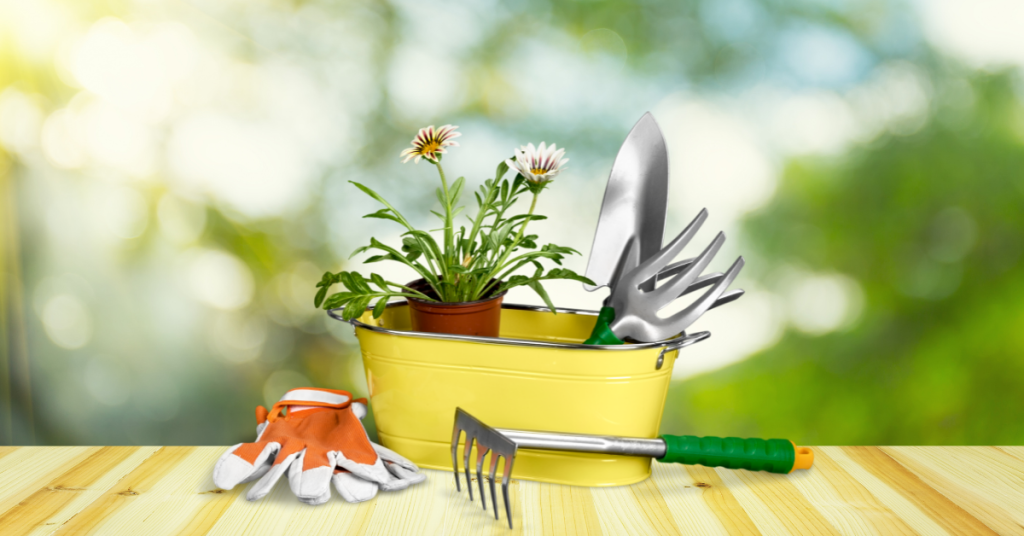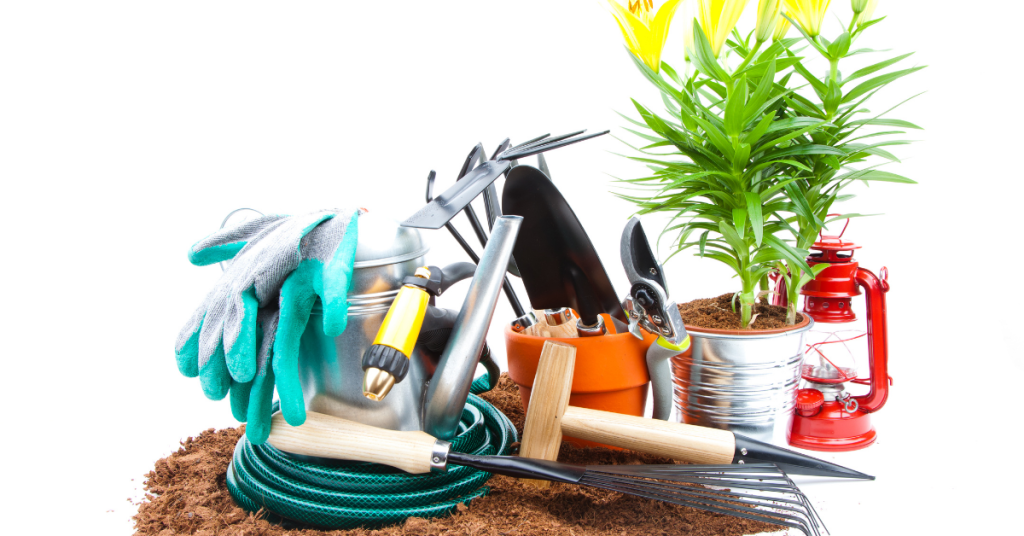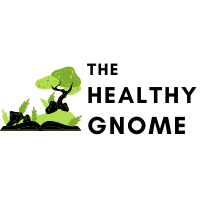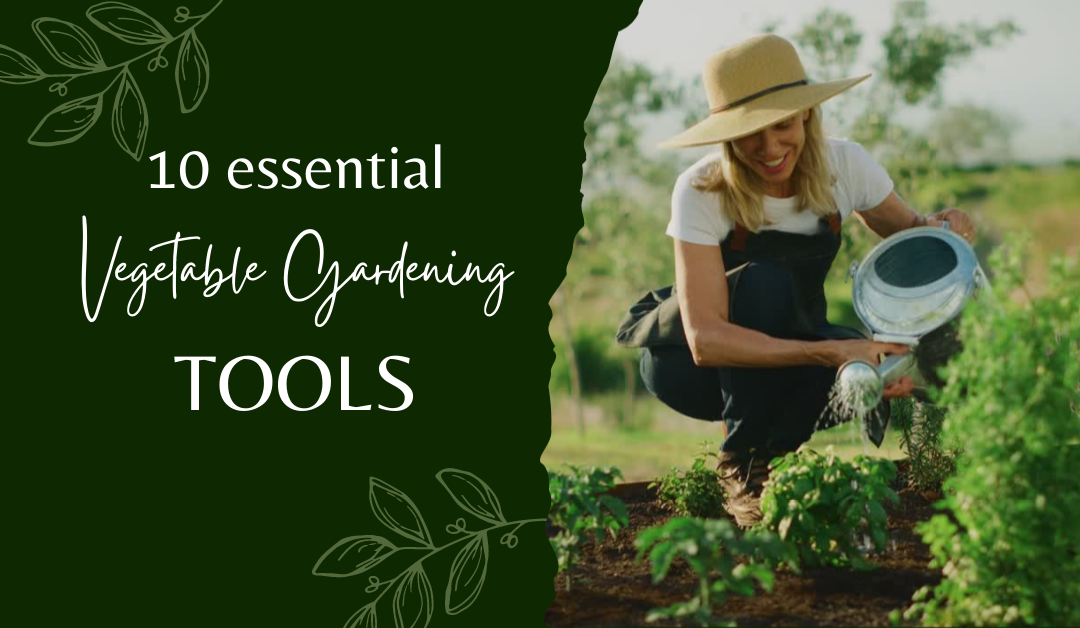Vegetable gardening is rewarding. It’s hard to beat the satisfaction of planting a seed (or seedlings!), caring for it and enjoying the fruits of your labor – literally. But many people who want to get into gardening are intimidated. Apart from the growing itself, they worry they’ll have to invest a lot of money in vegetable gardening tools with no guarantee of return.
But I’m here to say that that’s simply not true. You don’t need much to start gardening.
I know what you’re thinking, “Well, what kind of tools do I need for vegetable gardening?” I’m going to share a list of the most essential tools, and some that are just nice to have but not necessary.
Basic Vegetable Gardening Tools – Garden Essentials

1. Watering Can or Hose
A simple watering can makes it easy to water plants anywhere in your yard. If you don’t have a hose or can’t use a hose for whatever reason, a trusty watering can will get you through.
Look for a can that’s easy to carry even when full. Ideally, your watering can should be able to hold at least two gallons of water.
If you have the budget and space, consider getting a small water can, too. It’s much easier to water delicate herbs and plants in smaller containers with a smaller can.
A hose is another essential tool. It will save you a lot of time watering the garden and make it easier to ensure that your plants have all the water they need. Choose a hose that lets you adjust the intensity and type of spray. The “shower” setting is ideal for watering the garden because it won’t damage plants and mimics rainfall.
2. Hand Trowel
A hand trowel is an absolute essential for any garden because it has so many uses:
- Planting seeds
- Measuring soil depth
- Digging up weeds
Look for a trowel that’s easy for you to use with a comfortable handle. If your trowel is too heavy, you won’t want to use it. Trowels with sturdy, narrow blades will easily cut into the soil, saving you time and effort.
3. Hand Fork
Another essential gardening tool is the hand fork. Hand forks are great for removing small weeds and roughing up the soil. It’s handy for both garden beds and container gardening.
Invest in a good hand fork with a strong handle and shaft. Quality tools are more expensive, but they will give you years of use.
4. Hand Pruners
A pair of pruners should be in every gardener’s tool kit. They make quick work of trimming plants, shrubs and even small tree branches. In a pinch, you can use them to harvest without damaging the plant.
We recommend bypass pruners for vegetable gardening. These pruners have a top blade that slices past the bottom blade for a quick and even cut.
When you’re searching for pruners, you’ll also find anvil pruners. With these pruners, the top blade chomps down to the bottom blade, which can damage the plant.
For vegetable gardening, stick with by-pass pruners. Look for a pair with a comfortable grip and sharp blades.
5. Garden Rake
If you have garden beds, a rake will save you a lot of time and help you maintain a healthy garden. Rakes with steel tines can help spread compost and break up the soil for easy planting.
In a pinch, a leaf rake can work for the same purposes, but eventually, you’ll want to invest in a good garden rake. The rectangular and compact rake head make it easy to work for your garden bed, and the thicker tines can work the soil more easily.
6. Long Handled Shovels and Spades
A hand trowel is great to have, but for bigger jobs, you’ll want a long-handled shovel and spade.
- A straight-edge spade is great for digging holes, removing weeds, cutting roots and carving in edgings.
- Long-handled shovels with round, pointed blades are great for moving soil around and digging holes.
Invest in shovels and spades made from forged metal for longevity. Keep in mind that the longer the handle is, the more leverage you’ll have.
7. Harvest Basket
There’s nothing more rewarding than harvesting your vegetables in the summer and fall. A harvest basket will make it easier to transport all of your goodies from the garden to your kitchen.
There are so many great basket options out there. You can choose a traditional basket, or you can opt for a plastic one with a colander base. The advantage of having a basket with drain holes is that you can wash your produce outside, keeping soil and dirt out of your pipes.
8. Hose Reel or Hose Hanger
Having to untangle a hose can be tedious and time-consuming. A hose reel or a hose hanger will make your life easier by keeping your hose organized.
We recommend hose reels if your garden is further away from your home. You can find reels on wheels that make it easy to wind and unwind your hose and bring it where it needs to go.
9. Harvest Scissors
Among all of the basic tools for gardening, harvest scissors are often overlooked. We consider them essential because they make harvesting quick and easy without damaging the plant.
You can also use these scissors for deadheading flowers or pruning very delicate plants.
Look for scissors with sharp blades and a comfortable handle.
10. Gardening Gloves
Last but certainly not least on our essential list of garden tools is gardening gloves. A good pair of gardening gloves is essential because you just never know what you’re going to encounter when working in the garden.
Gloves will protect your hands when:
- Using fertilizer or laying down compost
- Working with prickly plants or plants that may irritate your skin
- Laying down mulch that may stain your hands
Gloves will keep dirt out of your fingernails and help prevent blisters and cuts when working with plants.
Make sure that you choose the right size for your gloves and that they feel comfortable when wearing them. Gloves with waterproofing are a bonus because they’ll keep your hands dry when working with moist soil.
Nice-to-Have Garden Tool List

Over time, you’ll find that your garden tool list keeps growing. In addition to the must-have, basic tools for gardening, there’s also a nice-to-have list.
Soaker Hose
A soaker hose makes your life easier by offering drip irrigation for your garden. You can easily move these hoses around, place them in a raised garden bed or even in a traditional garden. The idea is simple:
- Soaker hoses have tiny pores – thousands of them
- Water drips out of the hose slowly
- Plants are slowly watered
Since you’re placing the hose near the base of the plant instead of spraying from above, more of the water reaches the roots.
Hoses come in multiple lengths, so whether your spigot is 25’ or 100’ from your garden, a soaker hose is available to meet your needs.
You still need to turn on your water spigot like normal, but you’ll find soaker hoses allow you to spend more time tending to your plants and less time watering them.
Using a soaker hose is more efficient, but it’s still not one of our essential vegetable gardening tools. It’s a fantastic addition, but you can still water your plants sufficiently with a hose while investing in some of the other items on our list.
Watering Wand
Do you have plants hanging or have difficulty watering near the base of your plants? A watering wand can help.
A watering wand:
- Attaches to your hose
- Is shaped like a wand
- Water leaves the head of the wand
When tending to seedlings or hanging plants, a wand is much easier than a traditional hose. The water is dispersed more like a rain shower rather than a strong jet of water, so it’s perfect for young or sturdy plants alike. Most wands have a 45-degree angle, so you can get into tighter spaces, such as close to the base of the plant to reach the root system.
Compost Fork
Every garden can use a compost fork, and it looks a lot like a pitchfork. If you have a pitchfork, you can sub it for a compost fork. However, if you have compost for your vegetable garden, a compost fork offers:
- Large forks
- Sharp tines
Since compost may be difficult to mix, the sharper tines allow you to cut through thicker items in the compost pile and make it easier to turn.
Hori Hori Knife
A Hori-Hori knife is a type of gardening knife that comes from Asia. However, these knives are different from the gardening knife that you’re likely used to using. Instead, this knife mixes two tools:
- Trowel
- Knife
You’ll find that the Hori-Hori is more versatile than any one of these tools on their own and will make it easy to dig holes, cut down on weeds and even harvest. You’ll also find a few of these vegetable gardening tools with rulers printed on them to make it easier to dig holes for your plants with the appropriate depth.
Padded Kneeler
Do you find that kneeling down when gardening is killing your knees? You’re not alone. Padded kneelers are ideal if you like to kneel in your garden because they’ll alleviate pressure on your knees, making it far more comfortable tending to your crops.
Wheelbarrow
If you have the budget and space to store one, a wheelbarrow is a great investment for the garden. You can use it to haul soil or leaves, for weeding or collecting debris when you’re out in the yard.
Some wheelbarrows or garden carts can handle heavy loads, which is ideal for transporting rocks, bags of soil or other heavier items. Your back will thank you for buying a good wheelbarrow for your garden!
Garden Fork
A long-handled garden fork, or digging fork, is another handy tool to have in the garden. They make it easy to dig up weeds, remove dead or diseased plants and loosen up the soil. You can also use these helpful garden tools to transplant established plants to a new location.
Garden Hoe
Some gardeners consider a garden hoe one of the must-have garden tools. While I don’t personally think it’s essential, it can be helpful for removing shallow-rooted weeds. You can also use the tines to make little furrows for seeds. You’ll find garden hoes in a variety of sizes and shapes, so choose one that best suits your gardening needs. Look for ones with metal heads that are attached securely to the handle.
These are some of the best tools for vegetable gardening. To get started, you only need a handful of inexpensive tools. As you gain experience, you can start adding to your collection and investing in some of those nice-to-have tools.
Rene is a creative, little gnome. When she's not diving deep into research on health and wellness, she's spending here time out in nature, growing her homestead, photographing wildlife, doing yoga or enjoying a zen (depending on the day) moment with her fur babies. And on top of all of that, she's a professional writer by day, helping businesses around the world grow.

